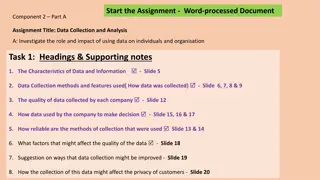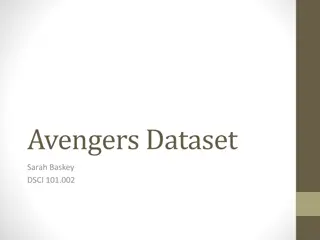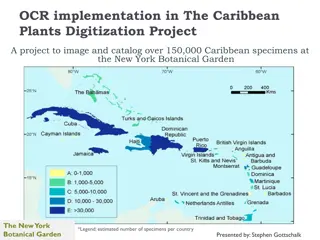
From Data Collection to Text Recognition: The OCR Training Dataset Journey
The journey of building an OCR training datasetu2014from data collection to model trainingu2014is essential for creating reliable and efficient text recognition systems. With accurate annotations and stringent quality control, businesses can unlock
Download Presentation

Please find below an Image/Link to download the presentation.
The content on the website is provided AS IS for your information and personal use only. It may not be sold, licensed, or shared on other websites without obtaining consent from the author. Download presentation by click this link. If you encounter any issues during the download, it is possible that the publisher has removed the file from their server.
E N D
Presentation Transcript
Downloaded from: justpaste.it/c6mkh From Data Collection to Text Recognition: The OCR Training Dataset Journey Introduction Artificial Intelligence (AI) is right at the forefront of change in industries and everyday life, speeding up processes and making routines much more intelligent and efficient. The most important of them is Optical Character Recognition (OCR), which is a machine-learning technology that enables the machines to read text extracted from images, documents, and handwritten notebooks. Nevertheless, for OCR to work, AI algorithms require high-quality and well-annotated OCR training datasets. What is the actual process of dataset creation in one case of OCR, and why is it so vitally important in the real-time improvement of the text recognition system? Let s take a journey through the process of creating and using an OCR Training Dataset. What is an OCR Training Dataset? A training dataset for Optical Character Recognition (OCR) is a set of images, documents, and handwritten texts that AI models employ to make sense of the images and thus develop the ability to recognize character, word, and the whole sentence. These datasets show AI systems
how to correctly interpret different fonts, handwriting styles, and various kinds of text in different settings. On a very basic level, the quality of the dataset determines how reliable and efficient the OCR technology is. The Process of Building an OCR Training Dataset Data Collection: Gathering Visual Information The beginning step of making an OCR dataset is the visualization (-Image-Image) of variant data. That may be: 1. Printed Text Materials: Books, newspapers, and magazines have become a fantastic source of printed texts that are used. 2. Handwritten documents are usually the ones that AI has more trouble reading. Handwritten notes, forms, and letters, thus, are very important pieces of data in the dataset. 3. Street Signs and Labels: Perfume labels, public signs, plus such as product labels become a significant sector thanks to the text they provide. In addition, one project was successful in generating images of more than 30,000 different ones, which consisted of the following: 15,000 were printed, 10,000 were written, and 5,000 were street signs and labels / product labels. Text Recognition: Annotating the Data When the images are collected, the following action is to annotate them. That means the person must carefully copy the text which is found in the image since it is easier for the AI model to identify words correctly. The process of annotation additionally comprises: 1. Identification of diverse handwriting styles, fonts as well as text direction. 2. Besides the main text, the contextual information such as the language used, the text format (printed/handwritten), and other metadata should also be added. One of the examples is the aforementioned project in which the team extracted data from 30,000 images and annotated them with the information that is exclusively vital for the AI system, thus it is an even more valuable dataset. Quality Assurance: Ensuring Accuracy Data quality is the key driver of AI models training, therefore it is somewhat very important for data to be of such a high quality. After annotation, it is also vital that a verification process is
followed to ensure that the transcriptions and the tags are accurate. 1. Annotation Verification: Random samples of the images that were annotated are checked in order to get accuracy. 2. Data Cleansing: Those that are blurred, out of context, and the ones that do not align to the project standards are deleted. 3. Security Measures: Privacy is safeguarded and people only use data that is protected to comply with legal standards. For instance, in the OCR project, the 3,000 (10% of the full) images were closely checked in the method, thus, making sure that only the high-quality data was used in training. Model Training and Testing OCR training data set the AI model is provided and then the AI model is trained to distinguish and understand text in all kinds of formats. This model is evaluated in terms of its ability to detect diverse types of writing (fonts, handwritings, and languages). Consistent modifications and corrections are done on the dataset according to the model's performance, thereby, making the OCR system cleverer with time. Real-World Applications of OCR Technology OCR has large and useful applications: 1. Enable Productivity and Privacy: OCR allows for the transformation of the text from scanned papers, receipts, and forms these can be automatically carried out by software without the involvement of a human. 2. Enhance Accessibility: If you are a visually impaired person, an AI-based OCR system can actually read out the text for you. 3. Digitization of Records: OCR can handle a wide range of manuscripts and legal text for the process of digitization and archiving thus making the retrieval of text very convenient. 4. Navigation Aid: OCR is used in AI to read street signs and give real-time driving directions to humans. The Future of OCR and AI
The progressive development in machine learning and AI has made the OCR technology become more precise and effective. A highly representative OCR training dataset is paramount for comprehending humans to a computer and to be able to be implemented in a number of casual situations. The end of the road is to create AI that can deal with all kinds of textual images on, for instance, a paper, a poster with writing on it, or a street sign. Conclusion: The Journey of OCR Training Dataset How an OCR training dataset is prepared from the collecting of data to text recognition is vital to improving artificial intelligence technology's ability to handle visual information. Collecting different kinds of visual data, paying great attention to annotation, and keeping high standards of quality, we can create AI models that are not only trustworthy but also scalable to a wide variety of text formats. Consequently, the improvement will be a more clever, quicker, and flexible OCR system that can transform businesses and the daily lives of people. If you are one of the people who want to develop their own OCR model, then getting a high- quality annotated training dataset is the very first stage that you must pass through if you wish to unlock the full power of AI-based text recognition. Conclusion with GTS.AI
At Globose Technology Solutions (GTS.ai), we specialize in leveraging advanced AI and machine learning techniques to build scalable and efficient OCR systems. By providing high- quality annotated datasets and custom OCR solutions, we help businesses unlock the full potential of text recognition technology, transforming their operations and user experiences.






















